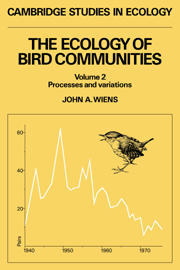Book contents
- Frontmatter
- Contents
- Preface
- Acknowledgments
- Part I Interpreting community patterns: process hypotheses
- 1 Competition
- 2 A case study: interactions among nectarivores
- 3 Beyond competition: other factors influencing community structure
- Part II Community variation in time and space
- Part III Prospects
- References
- Author index
- Subject index
2 - A case study: interactions among nectarivores
Published online by Cambridge University Press: 18 December 2009
- Frontmatter
- Contents
- Preface
- Acknowledgments
- Part I Interpreting community patterns: process hypotheses
- 1 Competition
- 2 A case study: interactions among nectarivores
- 3 Beyond competition: other factors influencing community structure
- Part II Community variation in time and space
- Part III Prospects
- References
- Author index
- Subject index
Summary
In the previous chapter, I described the difficulties of demonstrating interspecific competition and linking it with community patterns. Birds that feed chiefly upon floral nectar, however, are especially well-suited to investigations of competitive interactions, and it is therefore appropriate to consider their ecology in some detail.
In most parts of the world, a relatively small number of taxonomically related species comprise the chief members of the nectar-feeding guild: hummingbirds (Trochilidae) in the New World, honeyeaters (Meliphagidae) in Australasia, sunbirds (Nectariniidae) in Africa and parts of Asia, and honeycreepers (Drepanididae) in Hawaii. The species are often nectar specialists, and the resource of primary importance to them is thus clearly defined. Moreover, the abundance and availability of the nectar resource can be quantified with precision and related directly to the energetics of the birds. Many plants are adapted to pollination by nectarivorous birds (Stiles 1978, Feinsinger 1978, Feinsinger et al. 1982, Kodric-Brown and Brown 1979, Brown and Kodric-Brown 1979, Grant and Grant 1968), and in some cases the linkage between birds and plants suggests a tightly coevolved system. Because the flowers are adapted to make their nectar available to certain bird pollinators (Murray et al. 1987), measurements of nectar standing crop may accurately reflect resource availability as it is viewed by the foragers (Carpenter 1978). For these reasons, nectar-feeding birds and their resources have been popular subjects for investigations of time-energy budgeting (e.g. Wolf et al. 1975, Gill and Wolf 1977, Hixon et al. 1983), optimal foraging behavior (e.g. Pyke 1978), ecophysiology (e.g. Calder and Booser 1973), and species interactions.
- Type
- Chapter
- Information
- The Ecology of Bird Communities , pp. 64 - 88Publisher: Cambridge University PressPrint publication year: 1989



